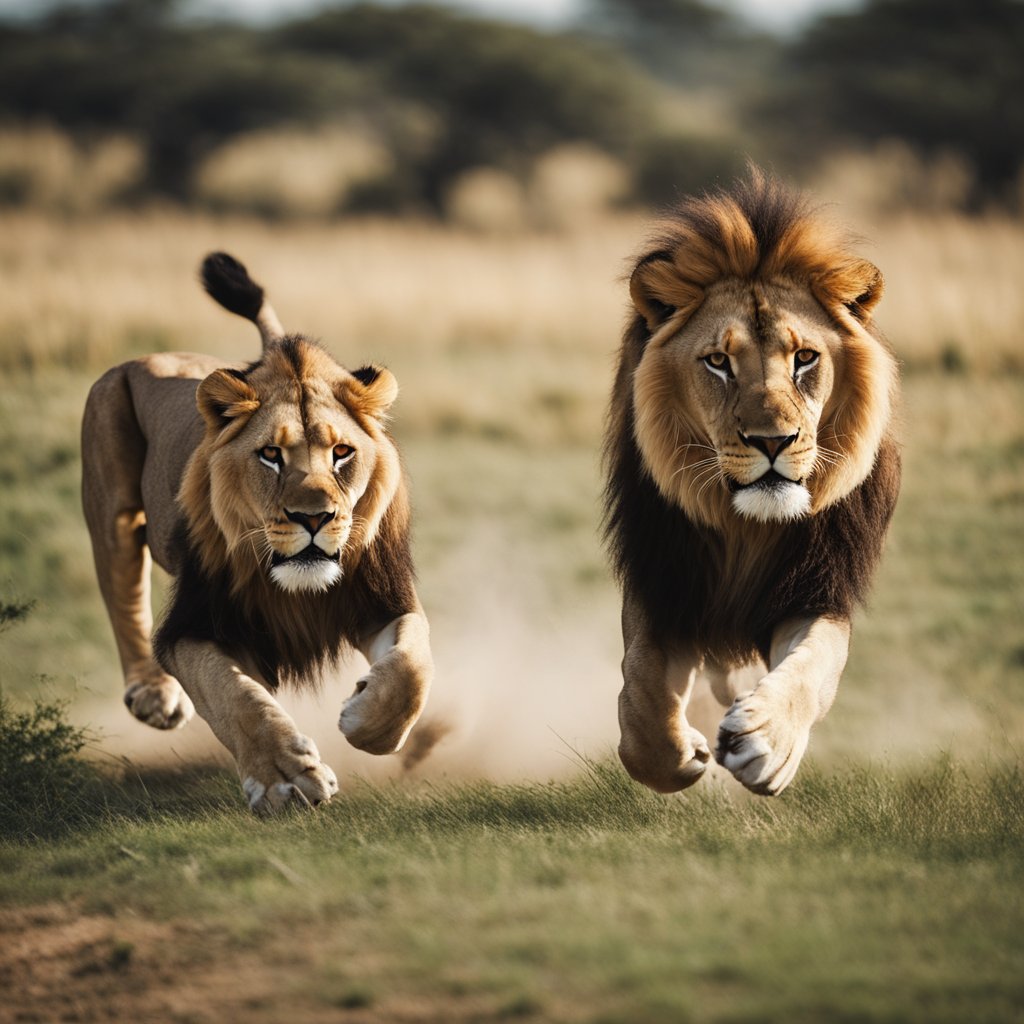
Male African Lions Hunt: Ambush Predators
Ambush predatorsMale African lions have long been a subject of fascination and study among researchers and wildlife enthusiasts alike. These majestic predators hold a unique position in the African savanna ecosystem due to their hunting behavior, specifically their ambush tactics. Their distinctive methods set them apart from other predators, distinguishing male lions from their female counterparts in terms of hunting and predation.
When it comes to the hunting behavior of male lions, their successful ambushes hinge significantly on factors such as habitat, prey availability, and vigilance. Their ability to remain concealed is crucial: utilizing thickly vegetated areas and spots with low visibility, male African lions can stay hidden until the perfect moment to strike presents itself. It’s important to note that the ambush tactics employed by male lions are quite different from those of female lions, who typically rely on cooperative hunting and superior agility.
Numerous studies have explored the nuances of lion predation, facilitated by advancements in technology like GPS tracking and radio collars. These research efforts have enhanced our understanding of these remarkable animals, as well as informed conservation initiatives aimed at preserving their habitat and populations. Knowledge gained through these studies benefits not only the academic community but also the general public, whose awareness and support are crucial to lion conservation.
Key Takeaways
- Ambushing is a primary hunting tactic for male African lions, setting them apart from their female counterparts.
- Factors such as habitat and prey availability significantly impact the ambush success of male lions.
- Technological advancements and research contribute to our understanding of these predators, informing conservation efforts.
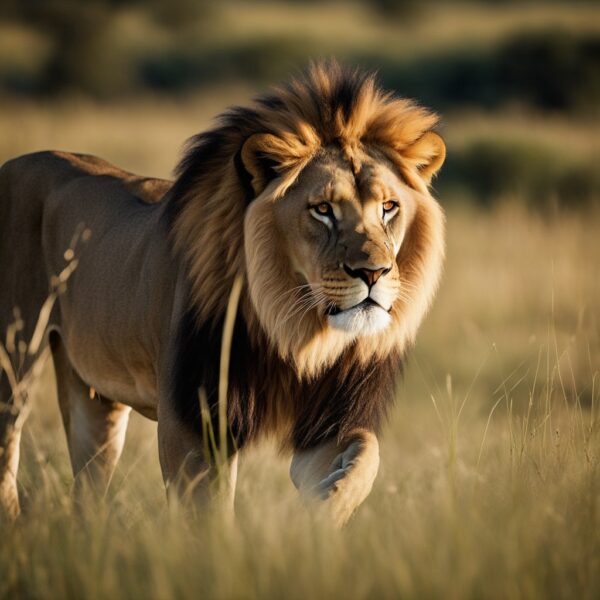
The African Male Lion is an ambush hunter
The African male lion, as a vital component of the African lion species, plays a dominant role in predator-prey interactions within the ecosystem of the African savanna. Known for its remarkable strength and agility, the male lion is a fierce apex predator capable of hunting a variety of prey, including large mammals.
One of the primary distinguishing factors between male and female lions is their sexually dimorphic features. Males are typically larger and possess a characteristic mane, which not only adds to their intimidating appearance, but also provides protection during territorial disputes or conflicts with other predators. Additionally, male lions possess greater physical strength compared to females, further enhancing their hunting capabilities.
As ambush predators, male African lions rely heavily on the vegetation and topography of their habitat to successfully hunt their prey. They utilize dense vegetation to conceal their presence, patiently waiting for the opportune moment to launch a sudden and lethal attack on their chosen target. This hunting approach is particularly effective among large mammals such as wildebeest, zebra, and even giraffe, which often fall victim to the strategic ambush techniques of male lions.
Despite their fearsome reputation, male lions are not solitary hunters. They often form coalitions with other males to enhance their hunting success and defend their shared territories. These cooperative efforts not only benefit each individual lion but also ultimately contribute to the overall stability of the lion population and the larger ecosystem in Africa.
In conclusion, the African male lion remains an emblematic figure in the African savanna, showcasing remarkable adaptability and prowess as an ambush predator. The interactions between male lions, their prey, and other predators form a complex web of relationships that shape the ecological balance within the continent’s diverse habitats.
Ecological Habitats of the Lion
African lions primarily inhabit the savanna, a diverse ecosystem characterized by grasslands with scattered trees and shrubs. This vegetation provides the necessary environment for lions to successfully execute their ambush predator tactics. Both dense savanna vegetation and open grassy savannas offer unique benefits for these kings of the African plains.
In areas with dense savanna vegetation, lions have ample cover to stalk their prey undetected. This type of habitat is essential for their ambush hunting strategy, as it allows them to get close enough to launch a sudden attack on unsuspecting herbivores. Kruger National Park in South Africa showcases this type of habitat, where lions often hunt within the thickets to maintain their element of surprise.
On the other hand, open grassy savannas also play a key role in the lion’s hunting strategy. Although this environment provides less cover, it allows for greater visibility and better detection of potential prey. Consequently, lions can effectively assess their surroundings and make a well-informed decision on whether to employ stealthy ambushes or simply approach their quarry directly. The Serengeti National Park in Tanzania is a prime example of an open savanna ecosystem, where lions have adapted their hunting techniques accordingly.
Ecological habitats also influence the lion’s interaction with other predators and prey species. For instance, they often avoid areas that are frequented by stronger competitors, such as hyenas, in order to minimize conflict and maximize their hunting success. Additionally, the availability and behavior of prey species in a particular habitat can directly impact a lion’s hunting and territorial strategies.
In conclusion, African lions are highly adaptable ambush predators that have developed specialized hunting techniques to suit their environment. Whether taking advantage of the cover provided by dense savanna vegetation or honing their skills in the open grasslands of the Serengeti, their ecological habitats continue to shape their behavior, interactions, and survival strategies.
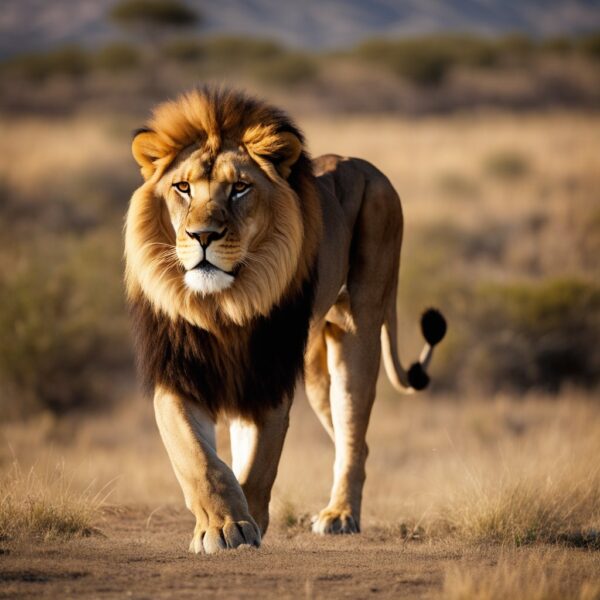
AMBUSH Hunting Behavior of Male Lions
Male African lions are known for their distinct hunting behavior, which often involves ambush-style hunting and cooperative strategies. They rely on their strength, stealth, and intelligence to capture prey, using well-planned tactics that maximize success rates.
One key aspect of male lions’ hunting behavior is ambush hunting. In this strategy, lions use the surrounding vegetation and landscape to hide from their prey, waiting for the right moment to attack. They usually select areas with dense vegetation and good lines-of-sight to conceal themselves and observe potential prey. This allows them to stalk their targets without being detected, and then pounce when the prey is within striking distance.
Another essential element of male lion hunting is their cooperative approach. Lions often hunt in groups or coalitions, working together to surround and corner their prey. This cooperative hunting behavior enhances their chances of success, as it allows them to effectively tackle larger and more formidable prey, such as African buffalo. In a coalition, each lion plays a specific role, and they constantly adapt their tactics based on the behavior of their prey and fellow hunters.
Moreover, male lions display a remarkable ability to switch between different hunting tactics depending on the situation. They can seamlessly transition from stalking and ambush-style hunting to more direct attacks like charging at their prey. This adaptability ensures they can successfully capture various types of prey, ranging from small antelopes to larger herbivores.
In conclusion, the hunting behavior of male African lions is marked by a combination of ambush hunting, cooperative strategies, and adaptability. They employ various tactics to increase their chances of success and secure food for themselves and their pride. This versatile and intelligent approach to hunting makes them formidable predators in the African savannah.
Role of Technology in Research
In recent years, technology has played a significant role in studying the behavior of male African lions as ambush predators. One key aspect of this research involves the use of Global Positioning System (GPS) telemetry. GPS data collected from collars placed on lions allows researchers to track their movements and understand their hunting patterns more effectively.
Moreover, 3-D maps created using LiDAR (Light Detection and Ranging) scanners provide a detailed visualization of the terrain inhabited by these predators. These high-tech measurements enable scientists to better comprehend how the lions use their environment to their advantage during ambush hunting. In addition, LiDAR-generated viewsheds, which are representations of the visible areas from a specific vantage point, can help researchers understand the lions’ field of vision, enabling them to predict potential hunting zones.
Studying behavioral patterns of lions in areas with different vegetation densities requires researchers to evaluate habitat use effectively. The incorporation of GPS telemetry data and LiDAR-generated maps allows for a precise analysis of the lions’ spatial behavior. This data can be used to identify the specific areas used by lions for ambush hunting, and how their preferences change depending on environmental conditions.
The integration of these technologies into wildlife research has greatly enhanced our understanding of male African lions’ behavior as ambush predators. By combining GPS data, 3-D maps, LiDAR scanners, and viewshed analysis, researchers continue to explore the complexities of these predators’ interactions with their environment and prey.
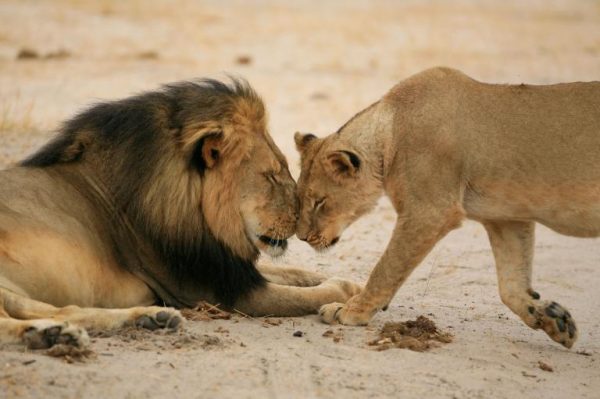
Male vs Female Lion’s Hunting Tactics
Male and female African lions both possess effective hunting skills, but their tactics and roles in the pride differ. While females are considered the primary hunters in a lion pride, male lions also contribute significantly to the overall hunting success.
Lionesses often hunt in coordinated groups, using their agility and stealth to stalk prey and execute ambushes. Their social organization allows them to efficiently take down larger prey as a group. On the other hand, male lions, although not as agile as their female counterparts because of their size and mane, apply their strength when required. In certain situations, such as defending territory or taking down exceptionally large prey, males will join in the hunt to provide extra muscle.
In terms of hunting tactics, male lions tend to adopt an ambush predation style. Studies suggest that males use ambush behavior more frequently than females, who rely on stealthy approaches and coordinated attacks. Male lions take advantage of their powerful build and search for ambush opportunities in the dense vegetation structure of the African savanna. They crouch in hiding, waiting for unsuspecting prey to come within striking distance.
The differences in hunting tactics between male and female lions can be attributed to their varying roles in the pride and their physiological differences. Female lions share the primary responsibility of providing food, which makes them more adept at group hunting and collaborative efforts. Meanwhile, male lions focus on defending their pride and territory, both against rival males and other predators. Their ambush predator tactics stem from the necessity of conserving energy while maintaining the power needed for their territorial defense.
In conclusion, both male and female African lions exhibit distinct hunting tactics that suit their respective roles within the pride. Lionesses excel at stealth and coordination in group hunting efforts, while male lions rely on their strength, size, and ambush predator tactics to dominate large prey and defend their pride. These hunting strategies allow both sexes to contribute effectively to the overall survival of the pride.
Conservation Efforts
Conservation of male African lions as ambush predators requires collaboration between park management, fire management, and a focus on conservation priorities. Ensuring the ecosystems they inhabit are preserved is essential for their survival.
Park management plays a crucial role in the protection and conservation of these powerful predators. By securing park boundaries, regulating tourism, and implementing anti-poaching measures, park officials can provide a safe environment for the lions. In addition, monitoring lion populations and their prey is essential to ensure a balanced ecosystem.
Fire management is another significant factor in maintaining suitable habitat for the lions. African savannas experience frequent fire outbreaks, particularly during the dry season. These fires can have both positive and negative effects on lions and their prey. Controlled burns can help create open spaces for improved hunting and visibility, while reducing the risk of intense wildfires that could lead to habitat destruction. Careful fire management is crucial to strike the balance between creating ideal hunting grounds and preserving the ecosystem as a whole.
Designating African lions as a conservation priority can help allocate resources to ensure their long-term survival. This includes funding for park management and fire management strategies, as well as research and conservation initiatives that directly benefit the species. Collaboration among governments, non-governmental organizations, local communities, and other stakeholders plays a pivotal role in ensuring the success of these conservation efforts.
In conclusion, the conservation of male African lions as ambush predators requires a holistic approach, focusing on park management, fire management, and the designation of lions as a conservation priority. With the right strategies in place, we can work toward securing a future for these remarkable predators.
Academic Studies on African Male Lion as Ambush Predator
Various institutions and foundations have been involved in the study of animal behavior, particularly focusing on the African male lion as an ambush predator. Researchers at the University of California, Berkeley, have conducted investigations to understand the behavioral adjustments of African herbivores concerning predation risk by lions. These studies examined spatiotemporal variations that influence habitat use and help better explain the ecological implications of predator-prey interactions.
In addition to the University of California, the Carnegie Airborne Observatory (CAO) has played a significant role in furthering predator research. The institution’s advanced technology has been valuable in assessing animal populations and their behaviors from an aerial perspective. This unique method has offered a more comprehensive understanding of predator-prey relationships, particularly for male African lions.
Funding for these ambush predator studies has come from various sources, including the Ecology of Infectious Disease Grant, the National Science Foundation, the James S. McDonnell Foundation, and the National Research Foundation. These grants have been instrumental in advancing our knowledge of male African lions and their role in the larger ecosystem.
Other foundations, such as the Andrew Mellon Foundation, the Gordon and Betty Moore Foundation, the Grantham Foundation for the Protection of the Environment, the Avatar Alliance Foundation, and the Margaret A. Cargill Foundation, have also supported research on predator behavior. Individual donors, like Mary Anne Nyburg Baker, G. Leonard Baker Jr, and William R. Hearst III, have contributed to research efforts as well.
Lastly, the Carnegie Institution for Science in Washington, D.C., has been a prominent institution in the study of animal behavior, with researchers collaborating on various projects to better understand male African lions as ambush predators. Their work has had a significant impact on our knowledge of these magnificent creatures and their role in maintaining the balance within their natural habitats.
Capture and Study Procedures
The process of capturing and studying male African lions for research purposes, such as understanding their ambush predator behavior, often begins with the cooperation of organizations like SANParks. SANParks, or South African National Parks, is responsible for managing and conserving wildlife in national parks across South Africa. Their experienced staff and veterinarians play a crucial role in capturing and handling wild lions.
To safely capture a lion, veterinarians use sedatives to immobilize the animal temporarily. The sedating process requires precision and expertise to ensure the dosage is effective and does not harm the lion. Once the lion is sedated, the team moves in to perform necessary tasks, such as fitting the lion with a monitoring device.
Collaring is an essential step in the study process, as it allows researchers to track the lion’s movements and collect data on its hunting behavior. Collars equipped with Global Positioning System (GPS) technology are carefully attached to the lion’s neck by experienced professionals. These collars enable researchers to monitor and analyze the lion’s location without disturbing its natural behavior, offering valuable insights into the lion’s predatory actions.
One of the key factors affecting the hunting success of male African lions is their choice of prey. Impalas, for instance, are medium-sized antelopes that are commonly found in the African savanna. They present a challenging target for lions, as their agility and speed make them difficult to catch. Studying lions’ predatory habits, including their preference for ambush locations, helps researchers understand the factors that contribute to their hunting success rates.
In conclusion, SANParks Lion Capture Procedures involve experienced veterinarians sedating the lion, collaring it with GPS tracking devices, and collecting data on their hunting behavior, such as their interaction with prey like impalas. This information allows researchers to better understand the complex behaviors of male African lions as ambush predators.
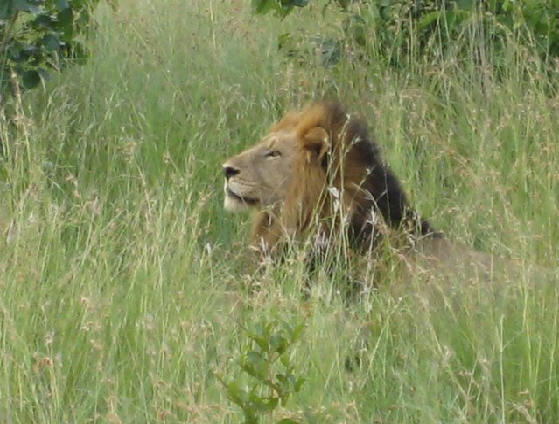
Frequently Asked Questions about male lions hunting
How do male African lions hunt in comparison to females?
Male African lions hunt differently than females. While females primarily focus on cooperative hunting and take the lead in capturing prey, males take part in hunting when prey is abundant or when they are forced to hunt on their own. Males rely more on their strength and power rather than stealth and coalition, which is a common strategy seen among females.
What is the role of male African lions within the pride?
Within a pride, male African lions mainly serve as protectors and defenders. Their primary responsibility is to maintain the territory and protect the pride from rival males and other potential threats. Males also contribute to hunting alongside the females when necessary, showcasing their strength and dominance, and ensuring the pride’s survival.
Do male African lions participate in hunting at night?
Male African lions indeed participate in hunting at night. In fact, lions generally prefer hunting during nighttime, as they benefit from the darkness and cooler temperatures. Ambushing their prey is a common strategy, which relies on cover provided by vegetation or the landscape. The dim and cooled environment allows lions, particularly males, to conserve energy during the hunt.
How do male lions protect their prides from rival males?
Male lions protect their prides by asserting dominance through physical displays, scent marking, and vocalizations. When rival males attempt to infiltrate the territory, male lions will engage in aggressive confrontations to establish dominance and protect their pride and offspring. Fierce battles may ensue, often resulting in severe injuries or even death.
Are there any specific prey preferences for male African lions?
Male African lions do not have specific prey preferences as such, but their larger size and strength enable them to target and take down larger prey like adult buffalo or young elephants. However, they are opportunistic predators and will seize any available prey, regardless of size or species, if the situation presents itself.
What factors influence male African lions’ hunting success rate?
Various factors can influence the hunting success rate of male African lions. Factors such as prey availability, vegetation cover, and environmental conditions play a significant role in determining the likelihood of a successful hunt. Hunting success may also be influenced by disturbances from other predators, the presence of prey herds, and the overall health and experience of the male lion.